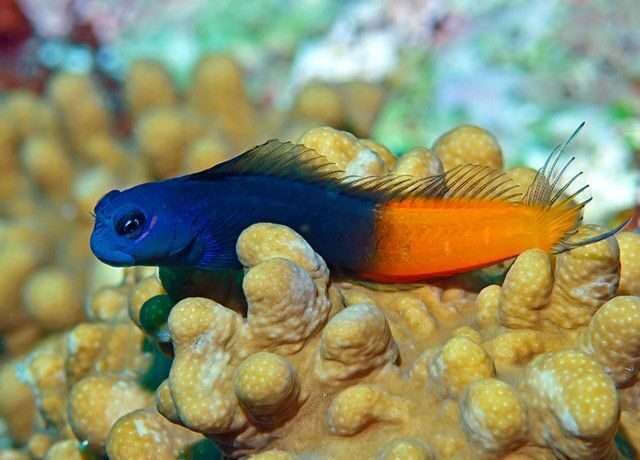
Size
When completely mature, it can grow to a length of 11 cm (4.3 inches).
Physical characteristics and behavior
The Bicolor Blenny’s body starts off with a front that is dark purple-gray to blue and gradually changes to bright yellow and orange as it moves toward the back. They have long cirri that stick out from between their blue-rimmed eyes, combing teeth for eating algae, and flourish in an established tank with abundant algae growth. Look for a male’s longer first dorsal fin, which will help you identify him from a female.
Habitat
The water in which a Bicolor Blenny lives should be kept between 72 and 78 degrees Fahrenheit. the water’s alkalinity or acidity. For Bicolor Blenny to thrive, the water’s alkalinity has to be between 8.1 and 8.4 pH.
Care as Pet

- Size of Tank
Bicolor Blenny requires a tank that is at least 30 gallons in size. Micro aquariums are not a good fit for this species. Even though they are small fish, they thrive in huge tanks with lots of live rock. Environments that are crowded can stress out your Bicolor and raise their propensity to attack other tank members.
- Tank Mates
Bicolor Blenny tank mates are typically calm and will only clash with other fish of their same kind. Every fish has a unique personality, and Bicolors are known to occasionally harass or fight other fish that consume algae because they perceive them as competitors for food.
- Tank Setup
Bicolor Blennies desire a lot of living rock with places to hide. This species consumes algae, hence it requires established aquariums with healthy ecosystems. At least a 30-gallon tank is recommended. Stress and increased hostility will result from smaller tanks.
There is no need for a deep sand bed. Although Bicolor Blennies consume algae, they do not sift sand like Gobies do. They may move sand and dig, but live rock is where they prefer to hide and feed. You should put live rock and other hardscape in your aquarium before sand. This will prevent anything that could cause damage from being dislodged by sand movement. Make sure the lid on your tank is solid and tightly fitting. This species is known for jumping, so it will get out of any tank that isn’t completely covered.
The amount of algae in many aquariums is insufficient to feed Bicolor Blennies. The majority of enthusiasts add prepared diets containing algae to the diet of their Bicolors. Maintaining a refugium where cultivable edible algae can be grown is another option. More copepods and other microfauna can be introduced to your tank’s ecosystem by using a refugium. A working refugium can supply algae and microfauna for a variety of fish in addition to Bicolor Blennies if you are creating a community tank.
- Diet
Bicolor Blenny can eat a variety of prepared meaty and vegetable diets, although they prefer to consume algae and plant matter. The algae bloom in many aquariums won’t be sufficient to meet the nutrient requirements of this species. Plan to add prepared meat and vegetable items to your Bicolor’s diet. Algae-containing frozen foods or algae pellets are great sources of extra food. Getting your Bicolor Blenny to identify prepared items as foods may be difficult. After being initially encouraged to bite into prepared foods, they ought to begin feeding consistently.
Table





